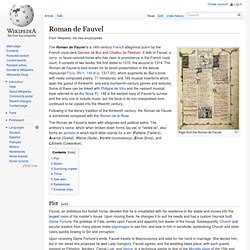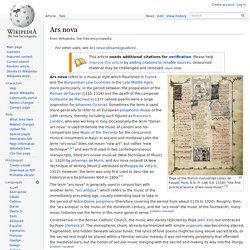

What is Ars Antiqua and Ars Nova? Roman de Fauvel. Page from the Roman de Fauvel The Roman de Fauvel is a 14th-century French allegorical poem by the French royal clerk Gervais de Bus and Chaillou de Pesstain.

It tells of Fauvel, a curry- or fauve-colored horse who has risen to prominence in the French royal court. It consists of two books, the first dated to 1310, the second to 1314. The Roman de Fauvel is best known for its lavish presentation in the deluxe manuscript Paris, BN fr. 146 (c. 1317-20), which augments du Bus's book with newly composed poetry, 77 miniatures, and 169 musical insertions which span the gamut of thirteenth- and early fourteenth-century genres and textures.
Some of these can be linked with Philippe de Vitry and the nascent musical style referred to as Ars Nova. Following in the literary tradition of the thirteenth century, the Roman de Fauvel is sometimes compared with the Roman de la Rose. The Roman de Fauvel is laden with allegories and political satire. Plot[edit] Music[edit] Surviving copies[edit] Trivia[edit]
Guillaume de Machaut. Machaut (at right) receiving Nature and three of her children. From an illuminated Parisian manuscript of the 1350s (sometimes spelled ) (c. 1300 – April 1377) was a Medieval French poet and composer . He is one of the earliest composers on whom significant biographical information is available. According to Daniel Leech-Wilkinson , Machaut was "the last great poet who was also a composer". Well into the 15th century, Machaut's poetry was greatly admired and imitated by other poets, including Geoffrey Chaucer . Machaut composed in a wide range of styles and forms. Guillaume de Machaut was born c. 1300 and educated in the region around Rheims . He was employed as secretary to John I , Count of Luxemburg and King of Bohemia , from 1323 to 1346 and also became a canon (1337). Machaut survived the Black Death that devastated Europe and spent his later years living in Rheims composing and supervising the creation of his complete-works manuscripts.
. [ edit ] Poetry [ edit ] Example 1987 - . Name. Ars nova. Page of the French manuscript Livres de Fauvel, Paris, B.N.

Fr. 146 (ca. 1318), "the first practical source of Ars nova music".[1] Ars nova refers to a musical style which flourished in France and the Burgundian Low Countries in the Late Middle Ages: more particularly, in the period between the preparation of the Roman de Fauvel (1310–1314) and the death of the composer Guillaume de Machaut in 1377 (whose poems were a large inspiration for Johannes Ciconia). Sometimes the term is used more generally to refer to all European polyphonic music of the 14th century, thereby including such figures as Francesco Landini, who was working in Italy.
Occasionally the term "Italian ars nova" is used to denote the music of Landini and his compatriots (see Music of the Trecento for the concurrent musical movement in Italy). Controversial in the Roman Catholic Church, the music was starkly rejected by Pope John XXII, but embraced by Pope Clement VI. Ars nova versus Ars antiqua[edit] Discography[edit]